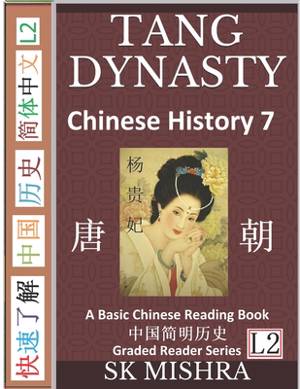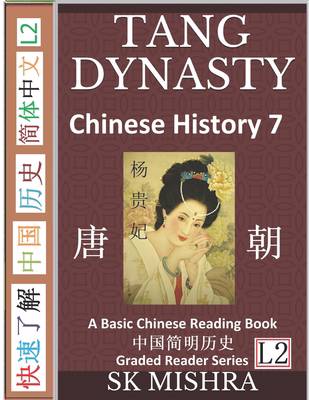
Door een staking bij bpost kan je online bestelling op dit moment iets langer onderweg zijn dan voorzien. Dringend iets nodig? Onze winkels ontvangen jou met open armen!
- Afhalen na 1 uur in een winkel met voorraad
- Gratis thuislevering in België vanaf € 30
- Ruim aanbod met 7 miljoen producten
Door een staking bij bpost kan je online bestelling op dit moment iets langer onderweg zijn dan voorzien. Dringend iets nodig? Onze winkels ontvangen jou met open armen!
- Afhalen na 1 uur in een winkel met voorraad
- Gratis thuislevering in België vanaf € 30
- Ruim aanbod met 7 miljoen producten
Zoeken
Chinese History 7
A Basic Chinese Reading Book, Tang Dynasty Culture and Civilization, History of Imperial China's Golden Age (Simplified Characters, Graded Reader Series Level 2)
Sk Mishra
€ 27,95
+ 55 punten
Omschrijving
The Tang Dynasty (618-907 CE) succeeded the short-lived Sui Dynasty (581-618 CE). The new dynasty was a very important Chinese dynasty that was founded by Li Yuan (with Chang'an as the capital) after overthrowing the Sui Dynasty. In fact, the Tang Empire was one of the most powerful countries in the world at that time. The Tang Dynasty had 21 emperors and ruled China for nearly 290 years. Due to its immense contribution to China's growth and development, the Tang Dynasty period is often termed as China's golden age. The book, Chinese History 7, a Chinese reading practice book, presents a broad and simple overview of China's Tang Dynasty and its legacies. The volume, 17th in the Mandarin Chinese Reading Series, includes both the Chinese text (simplified characters) and pinyin. With about 900 unique Chinese characters, the volume would be suitable for the beginners, lower intermediate and advanced level Chinese language learners (HSK 1-6). Overall, the Mandarin Chinese Reading Series offers you a variety of elementary level books (Level 1/2/3) to learn Chinese culture as well as practice Chinese reading fast. Paperback Edition:
https: //www.amazon.com/dp/1676157182
Kindle Edition:
https: //www.amazon.com/dp/B082TN347R The book has 11 chapters in the following order:
Chapter 1: The Sui Dynasty (第一章:隋朝)
Chapter 2: Overview of the Tang Dynasty (第二章:唐朝概述)
Chapter 3: List of Emperors of the Tang Dynasty (第三章:唐朝皇帝名单)
Chapter 4: Emperor Gaozu and the Establishment of Tang Dynasty (第四章:唐高祖与唐朝的建立)
Chapter 5: Emperor Taizong (第五章:唐太宗李世民)
Chapter 6: Empress Wu Zetian (第六章: 武则天, 中国武周时期女皇帝)
Chapter 7: Tang Xuanzong and Yang Guifei (第七章: 唐玄宗 与 杨贵妃)
Chapter 8: The Fall of the Tang Dynasty (第八章:唐朝的沦陷)
Chapter 9: Tang Culture (第九章: 唐文化)
Chapter 10: Buddhism (第十章:佛教)
Chapter 11: Tang Dynasty Poets (第十一章:唐朝诗人)
https: //www.amazon.com/dp/1676157182
Kindle Edition:
https: //www.amazon.com/dp/B082TN347R The book has 11 chapters in the following order:
Chapter 1: The Sui Dynasty (第一章:隋朝)
Chapter 2: Overview of the Tang Dynasty (第二章:唐朝概述)
Chapter 3: List of Emperors of the Tang Dynasty (第三章:唐朝皇帝名单)
Chapter 4: Emperor Gaozu and the Establishment of Tang Dynasty (第四章:唐高祖与唐朝的建立)
Chapter 5: Emperor Taizong (第五章:唐太宗李世民)
Chapter 6: Empress Wu Zetian (第六章: 武则天, 中国武周时期女皇帝)
Chapter 7: Tang Xuanzong and Yang Guifei (第七章: 唐玄宗 与 杨贵妃)
Chapter 8: The Fall of the Tang Dynasty (第八章:唐朝的沦陷)
Chapter 9: Tang Culture (第九章: 唐文化)
Chapter 10: Buddhism (第十章:佛教)
Chapter 11: Tang Dynasty Poets (第十一章:唐朝诗人)
Specificaties
Betrokkenen
- Auteur(s):
- Uitgeverij:
Inhoud
- Aantal bladzijden:
- 68
- Taal:
- Engels
- Reeks:
- Reeksnummer:
- nr. 17
Eigenschappen
- Productcode (EAN):
- 9781676157182
- Verschijningsdatum:
- 16/12/2019
- Uitvoering:
- Paperback
- Formaat:
- Trade paperback (VS)
- Afmetingen:
- 216 mm x 279 mm
- Gewicht:
- 181 g

Alleen bij Standaard Boekhandel
+ 55 punten op je klantenkaart van Standaard Boekhandel
Beoordelingen
We publiceren alleen reviews die voldoen aan de voorwaarden voor reviews. Bekijk onze voorwaarden voor reviews.











